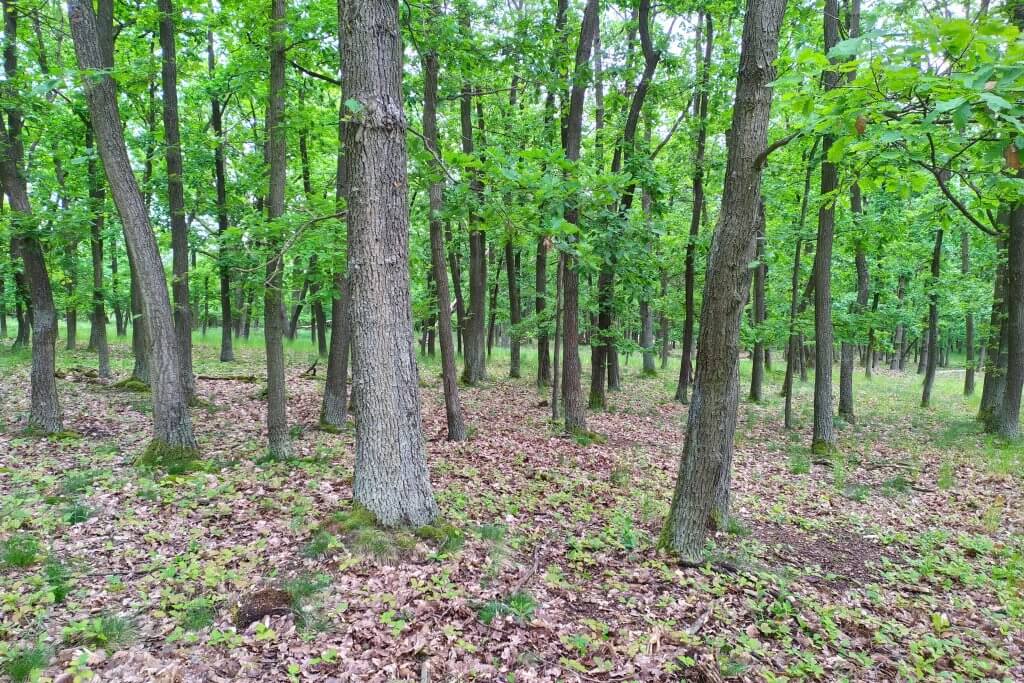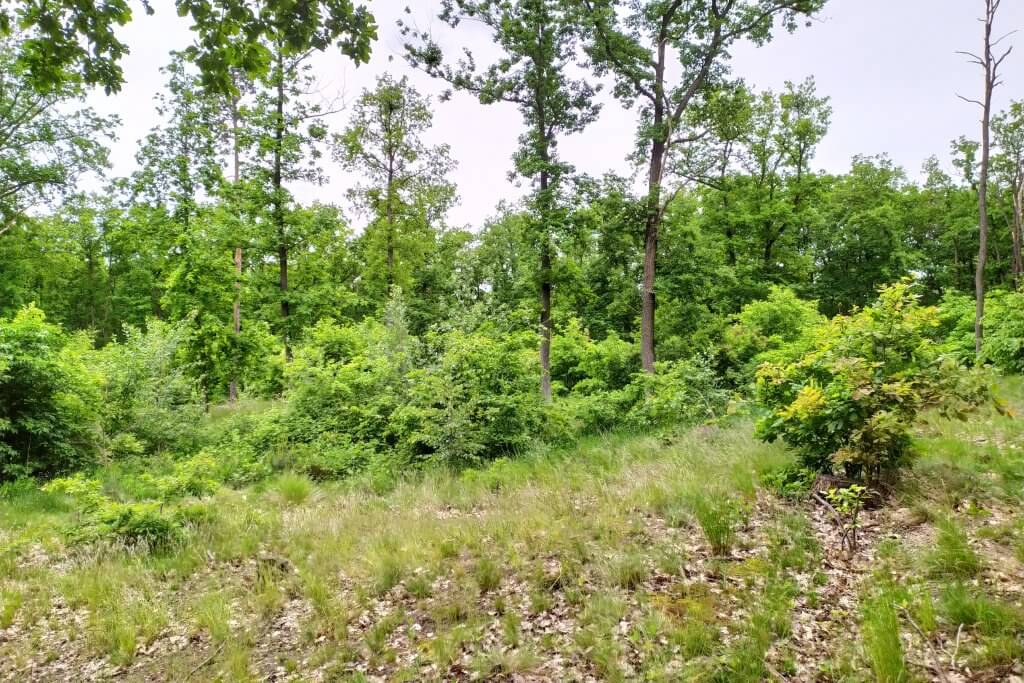Experts from the Faculty of Forestry and Wood Technology MENDELU (FFWT MENDELU) investigated how thinning forest stands and the subsequent development of the forest ecosystem affect communities of spiders living on the surface of the soil in forests of the Podyjí National Park. They have thus provided valuable information about how sensitive organisms, such as spiders, react to changes in the environment caused by the renewal of coppice management (stumping). A coppice forest is usually created after the felling of a tree in such a way that new tree shoots, so-called coppices, start to grow from the remaining stumps. The research clearly confirms the importance of the renewal of the coppicing system for the maintenance of biodiversity in protected oak forests. The conclusions of the research were published by the European Commission.
Organisms with diverse demands on the environment have thrived in forests that have historically been managed by coppicing, and therefore regular cutting, maintaining open habitat, and the subsequent occurrence of all phases of forest succession. The overall diversity in these lowland European forests ended with the abandonment of this form of management. Invertebrate animals became the most endangered group. “Spiders, in particular, are among the most diverse groups of invertebrate predators with specific demands on their environment, making them optimal bioindicators for assessing the state of the environment. Many rare and endangered species of spiders are dependent on light, open forest. With closure of the tree canopy, which occurs after the abandonment of the coppicing system, they are replaced by common shade-loving species,” says Tomáš Hamřík, from the Department of Forest Ecology.
However, until now scientists have lacked data on whether there will be an increase in biodiversity in places where the coppicing system is resumed. The study focused on the Podyjí National Park. Co-author of the study Ondřej Košulič, from the Department of Forest Protection and Wildlife Management, explains the reasons: “Historically, these forests were coppiced, which was gradually abandoned during the first half of the 20th century. Now, as part of the restoration, coppicing is being reintroduced and we are trying to understand the effects of this process. The study demonstrated a positive effect of the renewed coppicing system on the overall biodiversity of epigeic species, i.e., spiders living on the soil surface.”
“The greatest number of species were found in stands in an advanced stage of succession, i.e. at least five to six years after the renewal of coppicing. However, each stage of succession offered conditions for a different community of spiders. Open areas in the early stage (shortly after the renewal of coppicing) and advanced stages of succession hosted diverse communities of rare and endangered light-loving species. On the other hand, the undisturbed areas in the late stage of succession were typified by homogeneous communities with common shade-loving species,” Hamřík summarizes the conclusions of the study.
According to FFWT scientists, the research results unequivocally confirm the importance of the renewal of the coppicing system for the maintenance of biodiversity in protected oak forests.


The research project in the Podyjí National Park included specialists from the Hungarian Institute for Ecological Research – Centre for Ecological Research, led by Dr. Róbert Gallé, who is also involved in research on the impact of forestry management on the biodiversity of spiders in the floodplain forests at the confluence of the Morava and Dyje rivers.
“The aforementioned research provides new findings in the areas of community ecology and conservation biology. From a practical point of view, it brings results that emphasize the importance of restoring traditional methods of forest management for the protection of the biodiversity of lowland forests, and these findings are currently being successfully applied, for example, in the administration of NP Podyjí or PLA Pálava,” concludes Hamřík.
The research was financially supported by a project of the Internal Grant Agency of the Faculty of Forestry and Wood Technology MENDELU. The guarantor is Ing. Ondřej Košulič, Ph.D. Research focusing on the coppicing system is being carried out in long-term cooperation with Mgr. et MgA. Radim Hédl, Ph.D. from the Botanical Institute of the Academy of Sciences of the Czech Republic in Brno.
Text published by the European Commission
Caption for photo: An endangered ground spider of the genus Callilepis, which specializes in hunting ants. Both species of this genus were found abundantly in open stands. These are thermophilic spiders that are found in steppe or forest-steppe habitats with sparse vegetation.
Contacts for further information: Ing. Tomáš Hamřík, Department of Forest Ecology FFWT MENDELU, +420 605 453 461; tomas.hamrik@mendelu.cz; Ing. Ondřej Košulič, Ph.D., Department of Forest Protection and Wildlife Management FFWT MENDELU, +420 545 134 183; ondrej.kosulic@mendelu.cz
More news
-
The Horizon Europe project, Eurasian Network for Collaborative Research on Tree-Root-Mycorrhizal-Pathogen Interactions in Forest Soils (EuAsiaN-ROOT), coordinated by the Faculty of Forestry and Wood Technology, aims to provide a deeper…24. 6. 2025
-
Five Female Wolves Fitted with GPS Collars in the Beskydy and Javorníky…
Researchers from the Faculty of Forestry and Wood Technology at Mendel University in Brno have successfully captured and fitted GPS telemetry collars on five female wolves in the Beskydy and Javorníky Mountains over the past two years. These…28. 5. 2025 -
FFWT launches unique data collection on forest ecosystem functioning in MENDELU…
The Department of Forest Ecology at the Faculty of Forestry and Wood Technology of Mendel University in Brno (FFWT MENDELU), in cooperation with the Masaryk Forest Training Enterprise at Křtiny (ŠLP Křtiny), has launched monitoring of selected…23. 5. 2025 -
Professor Vladimír Tesař on the 30th anniversary of Pro Silva Bohemica: focus…
The Faculty of Forestry and Wood Technology and other stakeholders commemorated the thirtieth anniversary of Pro Silva Bohemica, an association of foresters dedicated to promoting close-to-nature forest management. Professor Emeritus Vladimír Tesař…9. 5. 2025 -
Scientists aim to determine which tree species have the most significant…
An international team studying the growth of 223 tree species across 160 experimental forests worldwide has found that conservative tree species—efficiently conserving resources such as nutrients, water, and energy—tend to grow faster under natural…16. 4. 2025 -
FFWT and UFE Křtiny partners of the ForDiL project supporting the education of…
The Faculty of Forestry and Wood Technology, Mendel University (FFWT MENDELU) and the University Forest Enterprise Masaryk Forest Křtiny (UFE Křtiny) are the main partners of the ERASMUS+ project Forest of the future: digital tools for learners to…11. 4. 2025 -
FFWT MENDELU and UFE Křtiny hosted Belgian students within the Erasmus+…
The students from Institut Technique Horticole de Gembloux were hosted by the Faculty of Forestry and Wood Technology, Mendel University (FFWT MENDELU) and the University Forest Enterprise Masaryk Forest Křtiny (UFE) as part of the Erasmus+ short…7. 4. 2025 -
Student Design 2025: the Upholstery Craft Award goes to MENDELU
The Student Design 2025 competition, held at the Mobitex fair at the Brno Exhibition Centre, awarded the works of students from secondary schools and universities from the Czech and Slovak Republics. The Upholstery Craftsmanship Award went to…2. 4. 2025 -
Pigeons' behaviour and habits in Brno: Research by the Faculty of Forestry and…
The Department of Forest Conservation and Wildlife Management at the Faculty of Forestry and Wood Technology (FFWT) has been conducting research on urban wildlife for more than two years. One part of the research focuses on wild pigeons,…26. 3. 2025 -
FFWT MENDELU participates in Diplomacy Week
The Faculty of Forestry and Wood Technology of Mendel University (FFWT MENDELU) is participating in Diplomacy Week, which takes place from 24 to 28 March 2025 in the Czech Republic. On this occasion, the Deputy Ambassador of Bosnia and Herzegovina…18. 3. 2025